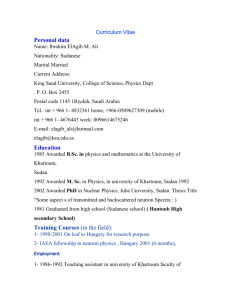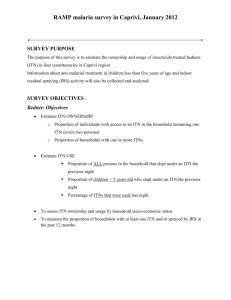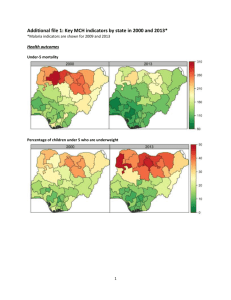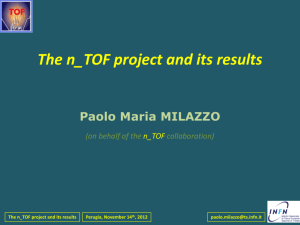Nuclear Instruments and Methods
advertisement
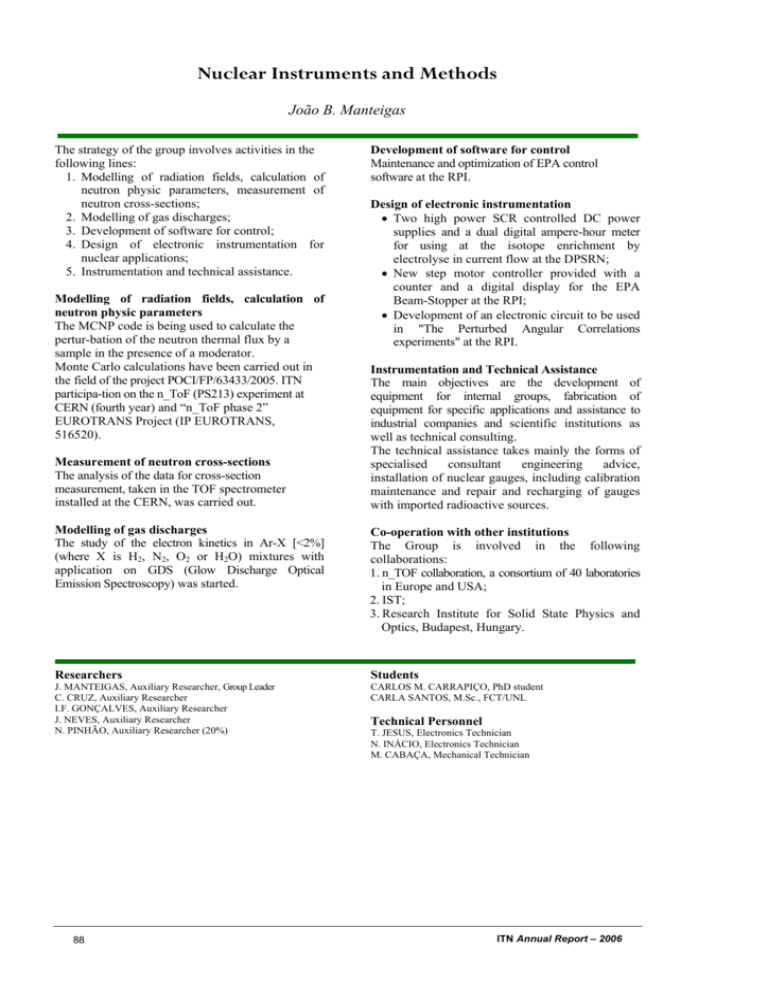
Nuclear Instruments and Methods João B. Manteigas The strategy of the group involves activities in the following lines: 1. Modelling of radiation fields, calculation of neutron physic parameters, measurement of neutron cross-sections; 2. Modelling of gas discharges; 3. Development of software for control; 4. Design of electronic instrumentation for nuclear applications; 5. Instrumentation and technical assistance. Modelling of radiation fields, calculation of neutron physic parameters The MCNP code is being used to calculate the pertur-bation of the neutron thermal flux by a sample in the presence of a moderator. Monte Carlo calculations have been carried out in the field of the project POCI/FP/63433/2005. ITN participa-tion on the n_ToF (PS213) experiment at CERN (fourth year) and “n_ToF phase 2” EUROTRANS Project (IP EUROTRANS, 516520). Measurement of neutron cross-sections The analysis of the data for cross-section measurement, taken in the TOF spectrometer installed at the CERN, was carried out. Development of software for control Maintenance and optimization of EPA control software at the RPI. Design of electronic instrumentation • Two high power SCR controlled DC power supplies and a dual digital ampere-hour meter for using at the isotope enrichment by electrolyse in current flow at the DPSRN; • New step motor controller provided with a counter and a digital display for the EPA Beam-Stopper at the RPI; • Development of an electronic circuit to be used in "The Perturbed Angular Correlations experiments" at the RPI. Instrumentation and Technical Assistance The main objectives are the development of equipment for internal groups, fabrication of equipment for specific applications and assistance to industrial companies and scientific institutions as well as technical consulting. The technical assistance takes mainly the forms of specialised consultant engineering advice, installation of nuclear gauges, including calibration maintenance and repair and recharging of gauges with imported radioactive sources. Modelling of gas discharges The study of the electron kinetics in Ar-X [<2%] (where X is H2, N2, O2 or H2O) mixtures with application on GDS (Glow Discharge Optical Emission Spectroscopy) was started. Co-operation with other institutions The Group is involved in the following collaborations: 1. n_TOF collaboration, a consortium of 40 laboratories in Europe and USA; 2. IST; 3. Research Institute for Solid State Physics and Optics, Budapest, Hungary. Researchers Students J. MANTEIGAS, Auxiliary Researcher, Group Leader C. CRUZ, Auxiliary Researcher I.F. GONÇALVES, Auxiliary Researcher J. NEVES, Auxiliary Researcher N. PINHÃO, Auxiliary Researcher (20%) CARLOS M. CARRAPIÇO, PhD student CARLA SANTOS, M.Sc., FCT/UNL 88 Technical Personnel T. JESUS, Electronics Technician N. INÁCIO, Electronics Technician M. CABAÇA, Mechanical Technician ITN Annual Report – 2006 NUCLEAR INSTRUMENTS AND METHODS Technical Assistance in the Field of Engineering Applications of Radiation and Radioisotopes J.B. Manteigas, J. Neves, C. Cruz Objectives The main objectives are the development of equipment for internal groups, fabrication of equipment for specific applications and assistance to industrial companies and scientific institutions as well as technical consulting. Results A summary of the more relevant work carried out is: (i) Collaboration in the installation of the “Ion Beam Laboratory – TANDEM 3 MV” at the Physics Sector. (ii) Maintenance and optimization of the “EPA Control Software” installed at the RPI. (iii) Technical support (development of electronic circuits) to be used in "The Perturbed Angular Correlations experiments" at the RPI. (iv) Development and maintenance of electronic equipment to RPI, Physics, Chemical, UTR and DPRSN Sectors Summary of the more relevant services/quipment rendered in 2006 Activity Qty Laboratory equipment for the determination of radioactive element traces by electrodeposition 1 1 1 Personal Radiation Dosemeter Equipment 4 1 Equipment Manufacturing 2 31 Technical assistance to - Source Containers Measuring and control of source activities ITN Annual Report – 2006 Price (€) 1 394,22 € 1 566,24 € 1613,69 € RPI - IRELAND NATS – OMAN IAEA – Sri Lanka ATOMEDICAL ESC. SUP. TEC. SAUDE 2420,00 € 726,00 € ITN/DPSRN CRIOLAB 1250,00 € 393,25 € 2 PORTUCEL/SOPORCEL – CACIA 1512,50 € 1 Siderurgia Nacional – Seixal 25 5 Prices including TAX (VAT) Client PORTUCEL/SOPORCEL – CACIA Siderurgia Nacional – Seixal TOTAL AMOUNT: 326,70 € 3587,65 € 635,25 € 15 425,50 € 89 NUCLEAR INSTRUMENTS AND METHODS Participation of ITN in the n-TOF experiment (PS213) at CERN (fourth year) and n_TOF phase 2 P. Vaz, I.F. Gonçalves, C. Cruz, J. Neves, C. Carrapiço, C. Santos, L. Ferreira, L. Távora1 A complete and precise knowledge of cross-sections for neutron induced processes is required for multiple applications, such as, the design of innovative Accelerator Driven Systems (ADS) and Energy Amplifier (EA) systems for the transmutation of nuclear waste and energy production, radioisotope production for medical and industrial applications and several topics in Astrophysics, Nuclear Physics and Nuclear Technology. Precisely measured neutron energy is required for the determination of the resonant structure of these cross-sections. The most suitable method to achieve such high resolution measurements is the use of short neutron pulses with a broad energy distribution, the energy of the neutrons being determined on the basis of their time-of-flight (TOF). The n_TOF Collaboration, a consortium of 40 institutions in Europe, U.S.A., Japan and Russia, has carried out successfully between 2001 and 2004 three experimental campaigns at the neutron time of flight (TOF) spectrometer at CERN, using the CERN/PS accelerator complex. In this facility, a proton pulse of 7×1012 protons of 20 GeV impinges on a lead target every 2.4 seconds. After collimation, a neutron flux of the order of 105 neutrons/cm2/pulse is available to perform cross section measurements in the detectors station located 185 m downstream the target area. The n_TOF phase2 project is the continuation of the involvement of ITN in the activities of the n_TOF Collaboration. The intention of the n_TOF Collaboration is to build a second n_TOF beam-line and a new experimental area (EAR-2) using a shorter flight path (20 meters), with lower backgrounds and count rates in the detectors, making possible the extension of measurements to higher energies and the availability of a higher neutron flux (a factor of 100). A team of researchers of ITN has been involved in Monte Carlo simulation activities, data analysis and development of electronics for the BaF2 calorimeter. ITN is strongly involved in collaboration with CIEMATMadrid and INFN-Bari in the following areas: Monte Carlo simulation(I) - full and detailed simulation of the geometry of the new experimental area, computation of the particle fluxes, assessment of the backgrounds, with the usage of the state-of-the-art Monte Carlo codes MCNPX and GEANT-4; Monte Carlo simulation studies (II) - continuation of the studies to simulate the response of the BaF2 calorimeter, calibration and efficiencies on a module-by-module basis; Data analysis (I) - continuation of the analysis of the following data sets: 197Au, 237Np, 240 Pu, initiated during 2005, using the BaF2 calorimeter; Electronics developments for the DAQ and the BaF2 calorimeter. ____________________ 1 Centro de Instrumentação / U. Coimbra __________________________________________________________________________________________ Electron kinetics in gas mixtures used for Analytical Glow Discharge Optical Emission Spectroscopy Z. Donkó, M. J. Pinheiro, N. R. Pinhão, P. Hartmann Glow discharge optical emission spectroscopy is a widely used method for quantitative analysis of the composition of materials. The method makes possible the investigation of metals, polymers, glasses and ceramics. The molecular gases present in the discharge as impurities – being sputtered into discharge from the investigated samples or being impurities of the background gas (typically nitrogen, hydrogen, oxygen and water vapor) – can falsify the emission spectra of the investigated samples making impossible the accurate quantitative analysis. Due to this effect many laboratories are working nowadays on the possibility to add to the noble gas small, but controlled amount of molecular gases, to investigate their effect on the emission spectra and to evaluate the necessary corrections to the measured spectra. The research on the effect of these molecular gases on the GDOES glow discharges is a actual subject. The aim of the present work is a study of the electron kinetics and transport properties in these glow discharges to understand how the added molecular gases affect the transport of electrons and their energy distribution. The energy distribution of the electrons can significantly influence the gas ionisation, the excitation of some spectral lines and their intensity, which contains the basic information from the point of view of analytical investigations. Thus calculation of the electrons velocity distribution function is of fundamental importance. Fig.: Electron energy distribution function in argon as a function of the reduced electric field (Função de distribuição em energia dos electrões em argon em função do campo eléctrico reduzido) 90 ITN Annual Report – 2006


